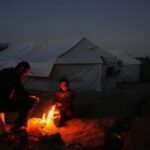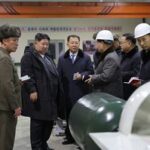Overcoming DMZ training
Successful combined arms training
Enhancement of mission capabilities

The 2nd Engineer Brigade of the Army reported conducting the overcoming DMZ maneuver training from the 11th to the 13th at the Ssangyong air land battle joint training range in Hwacheon-gun, Gangwon-do, to ensure the smooth maneuvering of wartime allies.
That day’s training was reportedly aimed at establishing methods for conducting combat operations to overcome the DMZ in a terrain similar to the DMZ through 24-hour combined arms.

Subsequently, they derived a direction for future development. The Ministry of National Defense revealed that the training involved over 100 soldiers from seven units, including the brigade, armored, infantry, intelligence, aviation, and CBR (chemical, biological, and radiological) units of the 2nd Engineer Brigade of the Army.
The training reportedly involved the deployment of various equipment, including the Armored Vehicle Launched Bridge (AVLB), the Mine Clearing Line Charge (MICLIC) K600, obstacle-clearing tanks, unmanned aerial vehicles (UAVs), K808 wheeled armored vehicles, KM9ACE armored combat earthmover, and excavators, totaling over 20 units.

The DMZ, filled with trees and wetlands, is a difficult area to navigate due to artificial obstacles and mines installed by North Korea after the Korean War. The Ministry of National Defense stated that overcoming the DMZ-overcoming maneuver training is a crucial element for the successful execution of our military’s operations.
That day’s training involved reconnaissance of the operation area with UAVs, suppression of the enemy with 500MD attack helicopters, and support for smoke screens. It was reported that the soldiers cleared obstacles and breached an avenue for maneuvering using various equipment despite the natural environment and artificial obstacles blocking their way. The validity of the operation plan was verified through successful combined arms.
The 7th Infantry Division in Hwacheon, Gangwon-do, also embarked on DMZ search operations. As befits the frontline, which reflects the serious security reality of the Korean Peninsula, they not only routinely search the DMZ but also often carry out ambush operations at night.
The search teams of the forward units responsible for the armistice line boundary conduct training by alternating between searching and ambushing in the DMZ as their operation area. The search teams selected for the day were reorganized mainly with non-commissioned officers for elitism, making it difficult to find soldiers of lower rank.

Last March, the 5th Engineer Brigade of the Army completed the DMZ-overcoming combined arms training at the Darakdae Training Field in Pocheon, Gyeonggi-do. They chose a combined arms method that integrated infantry, drone combat units, armored, CBR, and aviation units. The training also mobilized over 200 soldiers and more than 20 pieces of equipment.
The search battalion training field of the 28th Infantry Division of the Army is known to be so similar to the DMZ environment that people say it’s like the DMZ has been moved there. This is not a naturally formed environment but intentionally created within the division to resemble the DMZ.

The division stated that they tried to create a similar environment to fight and win against an enemy who tries to provoke at unexpected times by exploiting vulnerabilities.
They are particularly focused on the DMZ-overcoming operations. The soldiers’ mission is to search the DMZ, filled with tension as they never know when they might encounter the enemy, repeating the phrase, “The enemy will come to me.” They repeatedly train in an environment like real combat every day because they don’t know when and where the enemy will provoke.
In the DMZ combat skill mastery training, they focus on realistic behavior in real-world scenarios and conduct training to respond flexibly to enemy provocations and situations between operations.

It was also reported that the Army’s 2nd Corps recently created an environment similar to the DMZ and conducted training to overcome it. They demonstrated their prowess by deploying the Korean military’s Rhino obstacle-clearing tanks, also used in the Ukraine war.
When a giant stone blocked the road, the obstacle-clearing tanks were reportedly equipped with a crusher to break it into pieces and clear it out. The training that day was reportedly designed to guarantee the mobility of friendly forces in the DMZ and derive methods of breaching specific avenues for maneuver.
The Army soldiers who participated in the training that day said that although it was difficult to prepare, they gained confidence that they could overcome the DMZ after performing operations on the spot.















Most Commented